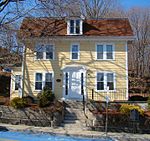Broad Street School
Buildings and structures in Norwich, ConnecticutNRHP infobox with nocatNational Register of Historic Places in New London County, ConnecticutSchool buildings completed in 1897School buildings on the National Register of Historic Places in Connecticut

The Broad Street School is a historic former school building at 100 Broad Street in Norwich, Connecticut. The school was designed by New York City architect Wilson Potter and built in 1897. It is a well-executed and well-preserved example of Romanesque styling, and was the largest school built as part of a major construction program by the city. The schoolhouse was listed on the National Register of Historic Places on January 19, 1984. It has been converted to residential use.
Excerpt from the Wikipedia article Broad Street School (License: CC BY-SA 3.0, Authors, Images).Broad Street School
Broad Street, Norwich Greeneville
Geographical coordinates (GPS) Address Nearby Places Show on map
Geographical coordinates (GPS)
| Latitude | Longitude |
|---|---|
| N 41.534722222222 ° | E -72.076388888889 ° |
Address
Broad Street 90
06360 Norwich, Greeneville
Connecticut, United States
Open on Google Maps










